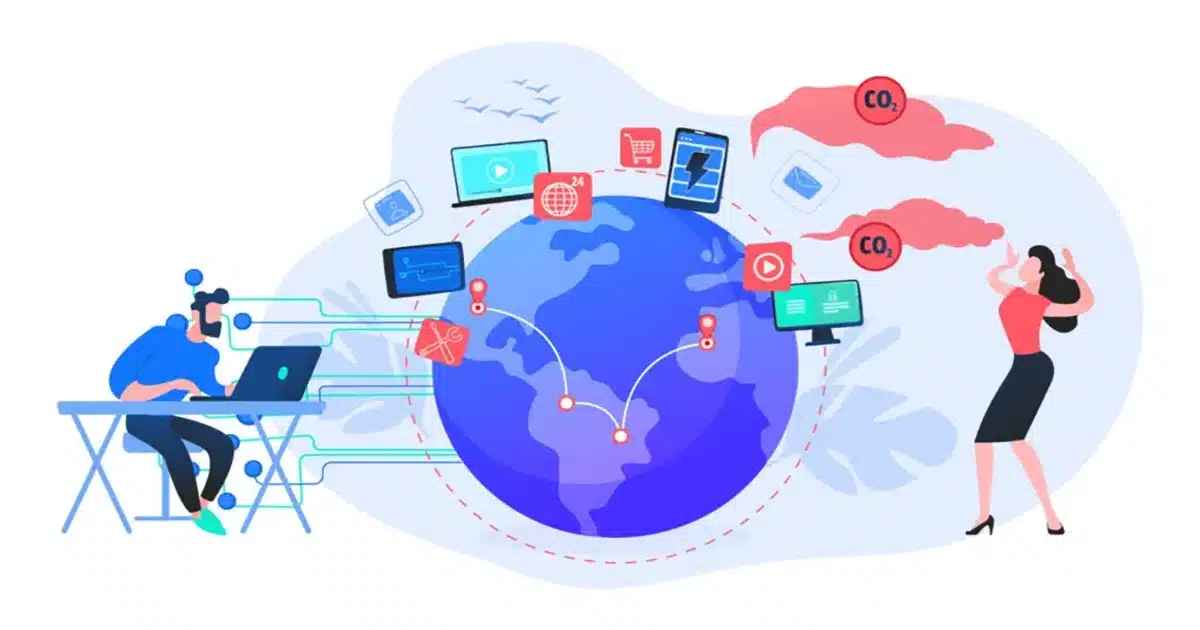Like all human activities, digital technology has an impact on the environment. Whether it’s the manufacture of hardware or the use and storage of data, digital technology pollutes.
And the figures are worrying. According to a study published in January 2022 by ADEME and the French Communications Regulatory Authority (Arcep), 10% of France’s annual electricity consumption comes from digital services and 2.5% of France’s carbon footprint is linked to digital (equivalent to the circulation of 13 million cars). 21% of digital pollution is generated using digital devices (smartphones, computers, tablets, etc.) and 78% by the manufacturing of these devices.
The problem is that, unlike a beach full of rubbish, digital pollution is invisible. It is therefore difficult to realise the impact of sending an e-mail or a video conference on the environment. Here is a brief overview of what digital pollution is, and how to reduce it.
What is digital pollution?
Digital pollution is generated by the manufacture and use of new technologies. It has many consequences:
– Greenhouse gas emissions, which are responsible for global warming.
– chemical contamination.
– erosion of biodiversity caused in particular by the extraction of minerals.
– depletion of resources.
– over-consumption of water and electricity.
– production of electronic waste.
Digital pollution is most significant in the production of IT equipment. For example, to manufacture a laptop, dozens of metals are needed from countries all over the world, and their extraction requires a lot of (fossil) energy, water, and resources. And the larger the equipment, the greater the environmental impact.
Another major source of pollution is servers or data centres. To send an e-mail, watch a video online or take part in a video conference, your device connects to servers located all over the world, which consume huge amounts of energy to operate and cool. This causes electricity consumption to skyrocket.
Finally, the recycling of IT equipment is another problem, as many households keep their unused or faulty electronic devices instead of recycling them. The concern is that they contain resources (cobalt, copper, etc.) that could be used to make new electronic devices or other products.
How to reduce digital pollution
How can we reduce our digital footprint when we work and communicate almost exclusively digitally?
Here are some good practices to reduce your digital pollution in your company.
1. Reduce and sort your emails
Did you know that sending and storing e-mails is a major source of pollution? One single e-mail represents 4g of CO2, and if you add an attachment, this figure can reach 50g of CO2. When you know that nearly 1.4 billion emails are sent per day in France, you can understand the urgency of reducing the number of emails sent.
Here are some good ways to reduce the digital pollution caused by your e-mails.
– Avoid sending unnecessary e-mails to say “thank you” or “have a nice weekend” to your colleagues. Only send essential emails.
– Use the phone instead and call your colleague to give them an instruction rather than writing a long email.
– Avoid copying the whole department or company on your emails. Target only the relevant recipients.
– Only send attachments when really necessary and keep them as small as possible. Use links to a storage space.
– Clean up your mailbox. Sort through your emails, taking care to delete unnecessary emails and spam.
– Unsubscribe from newsletters that do not interest you.
2. Consume differently
As we have seen, connected objects and electronic devices consume energy and pollute. So, to reduce your company’s digital pollution, avoid acquiring all sorts of connected objects that are not useful.
Don’t give in to the urge to buy new computers every three years and change your smartphone every year. If your IT devices work, keep them. Maintain them regularly to make sure they keep performing. If you still want to get rid of them, don’t throw them away but give them a second life by donating them to a charity or selling them.
If your equipment breaks down or is broken, have it repaired.
And if you have no choice but to buy, go for second-hand equipment and opt for reconditioned equipment (less expensive and less polluting) and/or equipment with the lowest possible energy consumption.
Finally, remember to switch off your computers and Wi-Fi box every evening when you leave, as these devices also consume energy when they are on standby. According to Ademe, a Wi-Fi box that is switched on 24 hours a day can consume more than 200 kWh per year, which is as much as a washing machine.
3. Change your habits
Finally, to reduce the digital pollution of your organisation, you need to change the practices and habits of your employees. Here are some examples.
– Store the data or files you use on a daily basis on your computer or on an external hard drive rather than on the cloud to avoid going back and forth to the servers.
– Bookmark websites you use regularly to avoid using a search engine every time, or leaving multiple tabs open all the time.
– Download videos instead of streaming them. According to Greenpeace, streaming video accounts for 60% of internet data flows, which is equivalent to about 1% of global CO2 emissions.
– Type the address of a website directly into the browser when you know it and use greener search engines than Google such as Ecosia or Lilo.
Follow these tips to fight digital pollution and reduce the environmental impact of your business.









